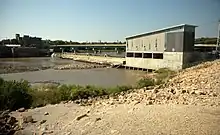
The Bowersock Dam is a run-of-river dam on the Kansas River in Lawrence, Kansas.[1] Constructed in 1874 to provide mechanical power, it now hosts the only hydroelectric plant in the state of Kansas.[2] The dam, which is 655 feet long and approximately 17.08 feet tall, supplies water to two hydroelectric powerhouses, which have a combined installed capacity of seven megawatts.[1] It impounds a 423-acre reservoir, which is used for recreation and as a water source for one of Lawrence's water treatment plants.[1][3]
History
For the first two decades after Lawrence's founding in 1854, the city's only sources of energy were wood and imported fuel. By the late 1860s, however, limited local timber resources had been depleted, and the city faced an energy crisis.[4] Looking to emulate the success of eastern water-driven industrial cities like Lowell, Massachusetts, local leaders entertained plans to build a stone dam across the Kansas River.[5] The city of Lawrence contracted with engineer Orlando Darling, who founded the Lawrence Land and Water Company (LL&W Co.) to manage the project.[6]

Due to structural problems and flood damage, including a destructive ice jam flood in 1873, Darling was unable to fulfill the terms of his contract with the city and resigned his position before the dam could be completed. Although LL&W Co. completed the structure without Darling, floods and slow development continued to plague the company, and it went into receivership in 1878.[7] The property was then purchased by James H. Gower, who conferred it upon his son in law, Justin De Witt Bowersock.[8] Apart from a small break in 1885, the dam withstood floods under Bowersock's leadership, and water power fueled substantial industrial growth in Lawrence in the late 19th century.[4]
After another ice jam severely damaged the original water mill in 1888, Bowersock improved the structure and installed four dynamos, which introduced electricity to Lawrence for the first time.[4] After a severe flood in 1903 destroyed the original mill, Bowersock constructed a new powerhouse designed primarily to generate hydroelectricity, although some businesses in Lawrence still used mechanical waterpower until 1972.[9] While electricity produced by the dam was initially directly distributed in Lawrence, the current operator of the dam, Bowersock Mills and Power Company (BMPC), sells power to the Kansas City Board of Public Utilities.[2]
Later in 20th century, changes in electrical infrastructure led to decreased demand for hydroelectric power from the dam, and the structure fell on hard times until a 1977 agreement between the BMPC and the city of Lawrence conferred responsibility for dam maintenance on the city.[4] In 2011, BMPC broke ground on a new powerhouse on the north end of the dam, substantially increasing its power output.[10] The new north powerhouse was completed in 2013, and brought the dam to a 7MW capacity.[11]
References
- 1 2 3 "LIHI Certificate #15 – Bowersock Mills Project, Kansas | Low Impact Hydropower". 2020-07-21. Retrieved 2022-10-11.
- 1 2 Ferhat, Yasmine (2022-09-01). "A Hidden Gem of Renewable Energy". Retrieved 2022-10-12.
- ↑ Robinson, John H. “Building for the Future: A New Generation of Water Treatment Plants in Kansas.” Journal (American Water Works Association), vol. 71, no. 6, 1979, pp. 310–14. JSTOR, JSTOR 41269793. Accessed 12 Oct. 2022.
- 1 2 3 4 "Our History". bowersockpower.com. Retrieved 11 October 2022.
- ↑ "Kansas River Improvement". The Daily Kansas Tribune. 12 May 1869. p. 2. Retrieved 11 October 2022.
- ↑ "The Council". The Daily Kansas Tribune. 25 December 1973. p. 5. Retrieved 11 October 2022.
- ↑ "Sheriff's Sale: State of Kansas, Douglas County, SS". The Lawrence Daily Journal. 19 December 1878. p. 2. Retrieved 11 October 2022.
- ↑ "FUNERAL OF J.D. BOWERSOCK HELD THIS AFTERNOON". The Lawrence Daily Journal-World. 28 October 1922. p. 1. Retrieved 11 October 2022.
- ↑ Black, Brian (1993). "Mastering the Kaw: The Bowersock Dam and the Development of Lawrence Industry" (PDF). Kansas History: 262–275.
- ↑ "Bowersock breaks ground on project to build new plant". LJWorld.com. Retrieved 2022-10-12.
- ↑ "Catfish, Cake Mix, and a Century of Clean Energy". Energy.gov. Retrieved 2024-01-04.